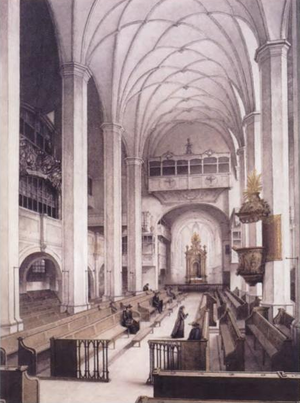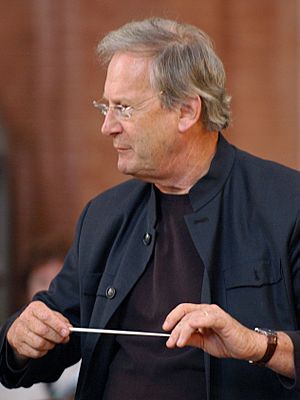Schwingt freudig euch empor, BWV 36 facts for kids
Quick facts for kids Schwingt freudig euch empor |
|
|---|---|
| Church cantata | |

Thomaskirche, Leipzig
|
|
| Related | based on 36c |
| Occasion | First Sunday in Advent |
| Performed | 2 December 1731: Leipzig |
| Movements | 8 |
| Vocal | SATB choir and solo |
| Instrumental |
|
Johann Sebastian Bach composed the church cantata Schwingt freudig euch empor (Soar joyfully upwards), BWV 36, in Leipzig in 1731 for the first Sunday in Advent. He drew on material from previous congratulatory cantatas, beginning with Schwingt freudig euch empor, BWV 36c (1725). The Gospel for the Sunday was the Entry into Jerusalem, thus the mood of the secular work matched "the people's jubilant shouts of Hosanna". In a unique structure in Bach's cantatas, he interpolated four movements derived from the former works with four stanzas from two important Advent hymns, to add liturgical focus, three from Luther's "Nun komm, der Heiden Heiland" and one from Nicolai's "Wie schön leuchtet der Morgenstern". He first performed the cantata in its final form of two parts, eight movements, on 2 December 1731.
History and words
Bach composed the cantata in 1731 in Leipzig, for the First Sunday of Advent, the beginning of the Lutheran church year. In Leipzig this was the only Sunday in Advent when a cantata was performed, whereas tempus clausum (quiet time) was observed on the other three Sundays. The prescribed readings for the Sunday were from the Epistle to the Romans, "night is advanced, day will come" (Romans 13:11–14), and from the Gospel of Matthew, the Entry into Jerusalem (Matthew 21:1–9).
Bach based parts of the music on a homage cantata of the same name, Schwingt freudig euch empor, BWV 36c, which he had composed for the birthday of a Leipzig University teacher and first performed in spring 1725. The text was probably written by Picander, who modified it to a congratulatory cantata for Countess Charlotte Friederike Wilhelmine of Anhalt-Köthen, Steigt freudig in die Luft, BWV 36a, first performed on 30 November 1726. Another version was a congratulatory cantata for a member of the Rivinius family from Leipzig, Die Freude reget sich, BWV 36b, probably in 1735.
Bach transformed the secular music to a cantata for the first Sunday in Advent, first by combining four movements and simply adding a chorale, the final stanza of "Wie schön leuchtet der Morgenstern". The librettist of this adaptation, who stayed close to the secular cantata without reference to the readings, is unknown. Klaus Hofmann notes that the jubilant opening matches the Gospel of the entry into Jerusalem "with the people's jubilant shouts of Hosanna". The date of the adaptation is not certain, because the version is extant only in a copy by Bach's student Christoph Nichelmann.
Finally in 1731, Bach reworked the cantata considerably and wrote a new score. He interpolated the arias not with recitatives, but with three stanzas from Luther's hymn for Advent, "Nun komm, der Heiden Heiland". This main hymn for the first Sunday in Advent had already opened his cantata for the same occasion in 1714, Nun komm, der Heiden Heiland, BWV 61, and he had used it as the base for his chorale cantata Nun komm, der Heiden Heiland, BWV 62, in 1724. The hymn stanzas "serve to anchor the cantata to some extent in the Advent story, and to give it liturgical purpose and a clear focus". John Eliot Gardiner terms it "structurally unusual". Bach divided the cantata in two parts to be performed before and after the sermon, closing part I with a stanza from Nicolai's hymn. For context, he replaced stanza 7, which had closed the whole cantata, by stanza 6, and closed part II by the final stanza of Luther's hymn.
Bach first performed the cantata on 2 December 1731, one week after Wachet auf, ruft uns die Stimme, BWV 140.
Scoring and structure
The cantata is scored for four soloists—soprano, alto, tenor and bass—a four-part choir, and a Baroque instrumental ensemble of two oboes d'amore, two violins, viola and basso continuo. It is structured in two parts of four movements each. Its interpolation of chorus and arias with chorales is unique in Bach's cantatas.
| No. | Title | Type | Vocal | Winds | Strings | Key | Time | |||||||||||||||||||||||||||||||||||||||||||||||||||||||||||||||||||||||||||||||||||||||||||||||||||||||||||||||||||||||||||||||||||
|---|---|---|---|---|---|---|---|---|---|---|---|---|---|---|---|---|---|---|---|---|---|---|---|---|---|---|---|---|---|---|---|---|---|---|---|---|---|---|---|---|---|---|---|---|---|---|---|---|---|---|---|---|---|---|---|---|---|---|---|---|---|---|---|---|---|---|---|---|---|---|---|---|---|---|---|---|---|---|---|---|---|---|---|---|---|---|---|---|---|---|---|---|---|---|---|---|---|---|---|---|---|---|---|---|---|---|---|---|---|---|---|---|---|---|---|---|---|---|---|---|---|---|---|---|---|---|---|---|---|---|---|---|---|---|---|---|---|---|
| 1 | Schwingt freudig euch empor | Chorus | SATB | 2ObDa | 2Vl Va Bc | D major | 3/4 | |||||||||||||||||||||||||||||||||||||||||||||||||||||||||||||||||||||||||||||||||||||||||||||||||||||||||||||||||||||||||||||||||||
| 2 | Nun komm, der Heiden Heiland | Choral | Soprano, alto | 1ObDa (col Soprano), 1 ObDa (coll'Alto) | Bc | F# minor | ||||||||||||||||||||||||||||||||||||||||||||||||||||||||||||||||||||||||||||||||||||||||||||||||||||||||||||||||||||||||||||||||||||
| 3 | Die Liebe zieht mit sanften Schritten | Aria | Tenor | 1ObDa (solo) | Bc | B minor | 3/8 | |||||||||||||||||||||||||||||||||||||||||||||||||||||||||||||||||||||||||||||||||||||||||||||||||||||||||||||||||||||||||||||||||||
| 4 | Zwingt die Saiten in Cythara | Chorale | SATB | 1ObDa (col Soprano), 1ObDa (coll'Alto) |
1Vl (col Soprano), 1Vl (coll'Alto), Va (col Tenore), Bc |
D major |
|



 In Spanish:
In Spanish: